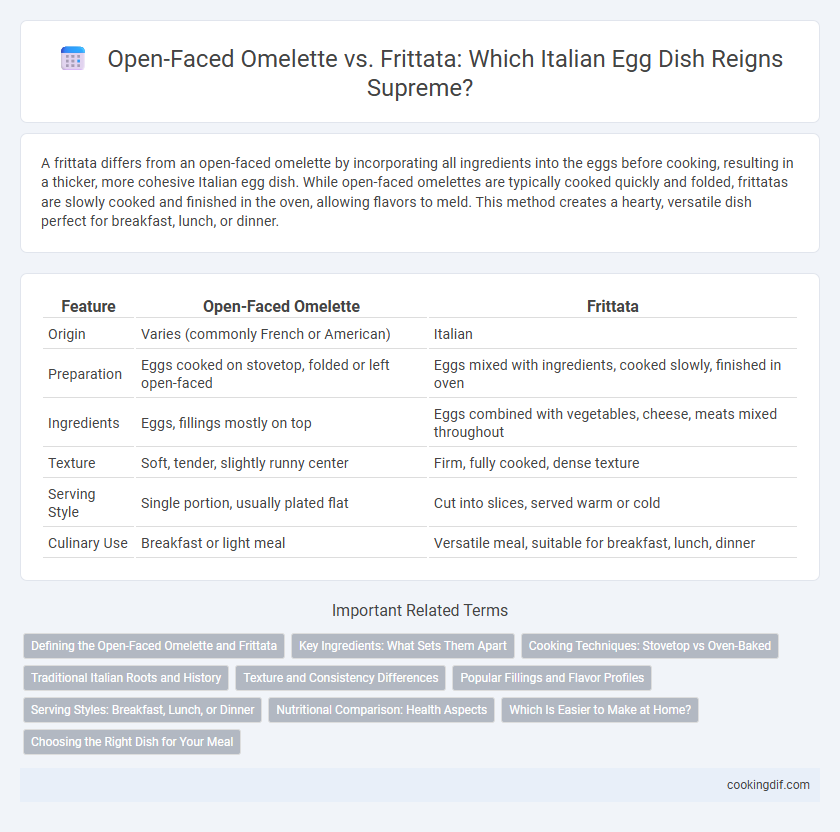A frittata differs from an open-faced omelette by incorporating all ingredients into the eggs before cooking, resulting in a thicker, more cohesive Italian egg dish. While open-faced omelettes are typically cooked quickly and folded, frittatas are slowly cooked and finished in the oven, allowing flavors to meld. This method creates a hearty, versatile dish perfect for breakfast, lunch, or dinner.
Table of Comparison
| Feature | Open-Faced Omelette | Frittata |
|---|---|---|
| Origin | Varies (commonly French or American) | Italian |
| Preparation | Eggs cooked on stovetop, folded or left open-faced | Eggs mixed with ingredients, cooked slowly, finished in oven |
| Ingredients | Eggs, fillings mostly on top | Eggs combined with vegetables, cheese, meats mixed throughout |
| Texture | Soft, tender, slightly runny center | Firm, fully cooked, dense texture |
| Serving Style | Single portion, usually plated flat | Cut into slices, served warm or cold |
| Culinary Use | Breakfast or light meal | Versatile meal, suitable for breakfast, lunch, dinner |
Defining the Open-Faced Omelette and Frittata
An open-faced omelette is a simple egg dish cooked quickly on one side, often folded or served flat, emphasizing a soft, creamy texture. A frittata is an Italian egg specialty that combines beaten eggs with fillings such as vegetables, meats, and cheese, cooked slowly over low heat and finished in the oven or under a broiler to achieve a firm, dense consistency. Unlike the open-faced omelette, the frittata is thicker, richer, and typically not folded, showcasing a layered blend of flavors characteristic of traditional Italian cuisine.
Key Ingredients: What Sets Them Apart
Key ingredients distinguish open-faced omelettes and frittatas in Italian cuisine, with frittatas typically including a mixture of cheeses like Pecorino Romano, cured meats such as pancetta, and vegetables like zucchini or spinach. Open-faced omelettes remain simpler, often relying on fewer fillings like fresh herbs and a single type of cheese, which keeps the texture lighter and more delicate. The use of beaten eggs combined with slower cooking methods also defines the frittata's dense, firm consistency compared to the softer, quicker-cooked open-faced omelette.
Cooking Techniques: Stovetop vs Oven-Baked
Frittatas are Italian egg dishes typically started on the stovetop and finished in the oven, allowing the eggs to cook evenly and develop a slightly browned top. Open-faced omelettes are cooked entirely on the stovetop, resulting in a softer, less firm texture without the baked crust characteristic of frittatas. The oven-baking process in frittatas enhances the melding of ingredients like vegetables and cheeses, distinguishing it from the stovetop-only cooking technique of open-faced omelettes.
Traditional Italian Roots and History
The frittata, a traditional Italian egg dish, differs from the open-faced omelette by its method of cooking and historical roots tracing back to regional Italian cuisine. Unlike the omelette which is typically folded, a frittata is cooked slowly and finished off in the oven, resulting in a thicker, heartier texture infused with local ingredients like cheeses, vegetables, and cured meats. This cooking style reflects Italy's culinary tradition of utilizing simple, fresh ingredients to create a versatile and satisfying meal that has been embraced throughout Italian culture for centuries.
Texture and Consistency Differences
An open-faced omelette typically features a softer, more delicate texture with a slightly runny center, while a frittata boasts a firm, dense consistency due to its slow cooking and baking process. The frittata's thick, custard-like interior contrasts with the airy and tender quality of an open-faced omelette. These texture variations influence the overall eating experience and suitability for incorporating diverse fillings.
Popular Fillings and Flavor Profiles
Frittata and open-faced omelettes both showcase a variety of popular fillings, including ingredients like spinach, mushrooms, tomatoes, cheese, and Italian sausage, each contributing unique flavor profiles. Frittatas often feature a richer texture and more complex taste due to the integration of ingredients throughout the egg mixture, while open-faced omelettes tend to highlight fresher, lighter toppings placed on top. Traditional Italian frittatas emphasize robust, savory flavors with herbs like basil and parsley, whereas open-faced omelettes offer a more delicate balance, often pairing mild cheeses with seasonal vegetables.
Serving Styles: Breakfast, Lunch, or Dinner
Frittatas serve as a versatile Italian egg dish ideal for breakfast, lunch, or dinner, often enjoyed warm or at room temperature with sliced vegetables or herbs. Open-faced omelettes, typically thinner and folded, are best suited for quick breakfast or light lunch servings, emphasizing simple fillings and a softer texture. Frittatas' dense, baked style allows for hearty meal options, making them popular for dinner alongside salads or bread.
Nutritional Comparison: Health Aspects
Frittatas contain more vegetables and protein-rich ingredients like cheese and meats, resulting in higher protein and fiber content compared to open-faced omelettes. Open-faced omelettes typically have fewer calories and less fat due to simpler fillings and quicker cooking methods. Both dishes offer essential nutrients, but frittatas provide a more balanced meal with increased vitamins and minerals from diverse ingredients.
Which Is Easier to Make at Home?
Frittatas are generally easier to make at home compared to open-faced omelettes due to their straightforward preparation, requiring minimal flipping and allowing ingredients to cook evenly in the oven or stovetop. Unlike open-faced omelettes, which demand careful folding and attention to cooking doneness to avoid breaking, frittatas involve mixing eggs with vegetables, cheese, or meats and baking them slowly, reducing the risk of errors. This simplicity makes frittatas a preferred choice for home cooks seeking a delicious Italian egg dish with less technique required.
Choosing the Right Dish for Your Meal
Frittatas offer a thicker, more substantial texture filled with a variety of ingredients mixed directly into the eggs, making them ideal for hearty meals or brunch. Open-faced omelettes, thinner and quicker to cook, highlight the toppings placed on top, perfect for lighter dishes or a quick snack. Selecting between these dishes depends on your desired meal complexity and portion size, with frittatas providing a rich, layered experience and open-faced omelettes delivering simplicity and speed.
Open-faced omelette vs Frittata for Italian egg dish Infographic

 cookingdif.com
cookingdif.com